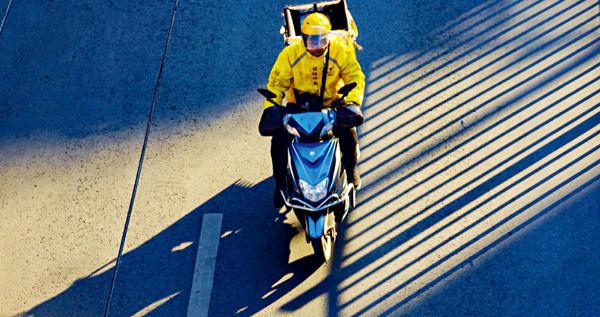A Day in the Life ofFood Delivery
Zhang Lijuan



Just before 10 a.m. on January17, Gao Feng, a food courier forMeituan, one of China’s biggest food delivery service providers, arrived at the Dawanglu Station of Beijing Subway to participate in a morning meeting.
Dawanglu Station is located in the eastern district of the InternationalTrade Center, one of Beijing’s busiest commercial districts. During themorning meeting, his manageroutlined potential problems andreminded Gao and his colleaguesof certain things before they started work.
A One-track Mind
After the morning meeting, Gaocame to the Gemdale Plaza (BeijingJindi center) at 10:10 a.m. “Generally,the first order comes after 10:20 a.m.,” he explained. “After the morningmeeting, we wait at the shopping mall for the first order.”
“You have an order from Meituan,” announced a text message, informing Gao of his first order at 10:20 a.m. Hewas instructed to deliver takeout from a restaurant in the Gemdale Plaza tothe tenth floor of the No.11 building of Wanda Plaza.
Rather than rush to the pickup,experienced Gao continued taking his time. “The restaurant just opened,”he explained. “It will take some timefor them to cook it.” Six minuteslater, Gao left for the restaurant. Assoon as he scanned his health QRcode upon arriving at the restaurant,the packaged meal appeared on thecounter.
"I have been a food deliveryman for years, and I pay attention to details,” Gao said of his fortuitous timing. After graduating from a secondary vocational school at age 18,Gao joined the armyand worked in artillery.An instructor described Gao as one with a "one-track mind" who is stubborn and assiduous.Gao would practice tidying up and train for an extra hour every night.He finally set a record by finishing a 5-kilometer run in only 18 minutes.
Gao started working for Meituan in April 2018. He concentrated on all the details of working food delivery and gained a lot of experience. Now, he hardly needs to look at a map to find any address in the area.
Responsible for Each Order
“My delivery area is the central business district (CBD) with a lot of office buildings,” he said. “Orders come in quickly during lunch hours from 11:00 a.m. to 1:00 p.m.” Gao reported receiving an average of 35 orders a day, 25 during lunch rush.
His phone incessantly chiming with new orders, Gao’s lunch hour was frenzied. Noon’s arrival brings the absolute peak, during which time the app assigned him two or three orders to be delivered together. Delivering three orders at once requires deft precision. Two addresses were in the same building, one on the eighth floor and the other on the fifth floor.
Despite the many flights to be scaled, Gao headed to the staircase instead of the elevator. “You cannot rely on elevators during the peak hours, because they are crowded and you have to wait while they stop at every floor,” he explained. “The stairs are always faster.”
He handedone bag of food to a customer on the fifth floor and another on the eighth. Despite breaking a sweat, he boltedback down the stairs to deliver thenext order. “I have to take the stairsduring peak hours or everything will be late,” he said.
By now, Gao knows his deliveryarea like the back of his hand. He pays close attention to all the informationon each order and knows whichbusinesses are closest to elevatorsand which are closer to staircases. He knows every entrance to a community and the best route to get to eachbuilding. Gao is also careful with thefood. He pays particular attentionto the temperature of the milk teahe delivers. If the beverage is icedand it is summer, he places them ininsulated cases.
But even in peak hours, Gaodoes not ride very fast. “I had twoaccidents,” he reported. “I got hit and the driver took full responsibility.Even though it was not my fault, Istill learned from the accidents. I donot run red lights or go the wrongway down one-way streets. I don’tspeed even if I lose money because of it.”
“The floor at this address is too high, so we have to wait for the elevator,” he sighed. “We’re going to be four minutes late.”Despite his best efforts to rush, he still called thecustomer to apologize forbeing late while waitingfor the elevator. When hehanded over the food, he apologized again.
Gao’s enthusiasmand efforts make him an excellent food deliverydriver. Records of about800 deliveries in a month show his punctualityrate at 99.8 percent andcustomer satisfactionat 100 percent. “I wasdevoted to militaryservice as a soldier, andnow I serve the peoplethrough delivery,” he said.
“I take full responsibility foreach order.”
Rapid development of theplatform economy has causeda significant increase in newemployment forms of workers.As the economic scale of thetakeout delivery market grewto hundreds of billions ofyuan, about 7.7 million peoplebecame involved in fooddelivery, including Gao. Theyare like the pulse of the cities,and their contributions areindispensable. Even during the 2020 Spring Festival holidayamid COVID-19 pandemic,nearly 20,000 food deliveryworkers shuttled acrossBeijing delivering orders thatnumbered 400,000 each day on average.
Veteran Rider
“Now that 25 orders havebeen delivered, over half ofthe day’s work is done,” Gaogrinned. “It’s time to havelunch.” At 1:10 p.m., Gao signedoff his order-receiving system.Between 1:30 p.m. and 5:00 p.m. are the off-peak hours duringwhich time he only receivesabout four or five orders.
But he still stays careful. Gao has gone to the wrong addressbefore. Once, an order wasscheduled for delayed delivery,so Gao didn’t pay muchattention to it as he was chatting with a friend on his phone.Because of all the chatting, hemistakenly went to the wrongbuilding. “You are a veteranrider and shouldn’t make suchsilly mistakes,” chided thecustomer, an admonition Gao still remembers clearly.
Gao is always ready to helpothers. He donates moneyfor people in need, turns onhis headlights to illuminatethe roads for people walkingat night, and even takescustomers’ trash out for them.His kindness has been rewarded with favorable commentsnot only from customers butrestaurateurs alike.
The evening peak hoursarrive at 5:00 p.m. Gao got busy again. He was notified to deliver takeout from the CBD WandaPlaza in Chaoyang District toNo. 10 Langjiayuan Road. Gaotook an overpass far from theroute he took hours before.
Evening rush hour traffic was to blame. Traffic jams tend todelay his evening travels on the streets. “In the CBD, the trafficbegins as early as 5:00 p.m. You have to use the overpass, or you will be late every time.”
He received a total of sixorders during the dinner hours. “Because of the traffic, thenumber of orders in businessareas during this time period is not very high actually,” he said. “But I still usually work till 8:00 p.m.”
Gao logged out of the appagain at eight sharp. “Now I am going to pick up my wife fromwork,” he said. He finished35 orders that day. “That’sabout average for me. I’m not exhausted by 35, and that’s a decent workload for me.”
Extraordinary people canexcel even at the most ordinarywork. “The job in food deliverybrought great changes to me andmy family,” Gao said. “I earn aguaranteed salary of about 10,000 yuan a month, and my familylife is improving.” Gao hopes tocontinue studying and earn abachelor’s degree to make goodon his plans for the future.

